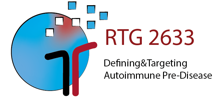Wing Yu Lee
Skin-infiltrating T and B cells in the pathogenesis of pemphigoid diseases
T-cell/B-cell interactions are a central component in the pathogenesis of all antibody-mediated auto-immune diseases. This usually take place in secondary lymphoid organs (SLO) where follicular T helper (Tfh) cells drive the differentiation of B cells into high-affinity antibody-secreting cells. Interestingly, similar reactions can also occur directly in inflamed non-lymphoid tissues. There, the recently described CD4+ T cell population of peripheral T helper (Tph) cells shares numerous features with Tfh cells, including their ability to provide B cell help. Unlike Tfh cells, which interact with B cells in the highly organised environment of SLO, Tph cells reside in unstructured T cell / B cell infiltrates in the inflamed tissue. This uncontrolled T/B cell interaction poses a high risk for the formation of auto-reactive antibodies. In addition, the tissue-resident inflammatory B cells have a particular phenotype characterised by expression of the transcription factor T-bet.
Pemphigoid diseases (PDs) such as bullous pemphigoid (BP) and epidermolysis bullosa acquisita (EBA) are prototypical autoantibody-driven diseases. However, how the autoantibodies are formed is still largely unclear. Besides cells of the innate immune system, T and B cells are also abundant in the skin lesions of PDs patients. However, their contribution to pathogenesis has not yet been explored in detail. Our preliminary data suggest that peripheral T helper (Tph) cells and T-bet+ B cells are highly proliferated in the peripheral blood of BP patients and that T cells interact directly with B cells in lymphoid infiltrates in the skin.
The influence of novel T cell populations, i.e., Tfh and Tph cells, on autoantibody-mediated inflammatory skin diseases is investigated in the EBA immunisation-induced mouse model. To this end, we aim to develop a new therapeutic approach for such diseases by modulating Tfh and Tph cells and their functions.

- People
- Doctoral Candidates
- Merabell Adem
- Katja Adriany
- Farbod Bahreini
- Estelle Bergmann
- Swayanka Biswas
- Jana Buhre
- David De Luca Laredo
- Kaan Ersoy
- Ferdinand Gebauer
- Sen Guo
- Veronika Hartmann
- Michelle Hein
- Luise Janusch
- Maj Jäpel
- Anna Knauer
- Valentin Kneitz
- Maximilian Lahmer
- Wing Yu Lee
- Daniel Mehlberg
- Sahar Mehrabani
- Afsaneh Mehrpouyan
- Sadegh Mousavi
- Milica Novovic
- Justus Ohmes
- Bianca Opelka
- Colin Osterloh
- Cristian Papara
- Tina Rastegar Lari
- Rochi Saurabh
- Alessia Maria Sbaraglia
- Jovan Schanzenbacher
- Mareile Schlotfeldt
- Carolin Schmidt
- Solveig Lea Schmidt
- Leon Schmidt-Jiménez
- Nora Schoell
- Salomini Sinnathurai
- Sarah Stenger
- Chiara Walczyk
- Nele Wellbrock
- Julia Wimmer-Gross
- Natalia Zappe
- Jianrui Zheng
- Luca Zillikens
- Carla Zünkeler
- Principal Investigators
- Associated Scientists
- Administration
- Doctoral Candidates




